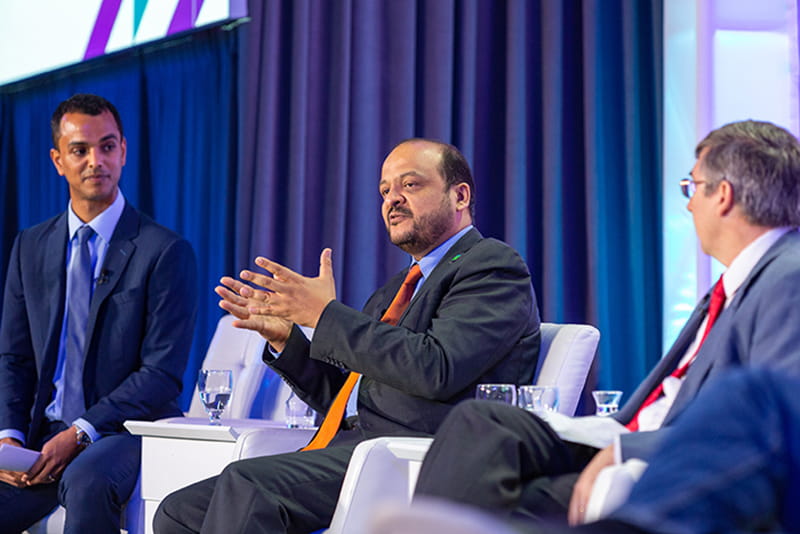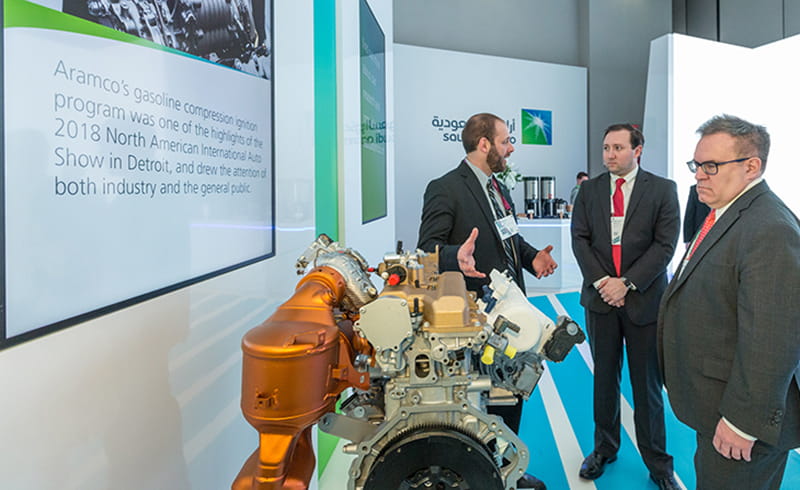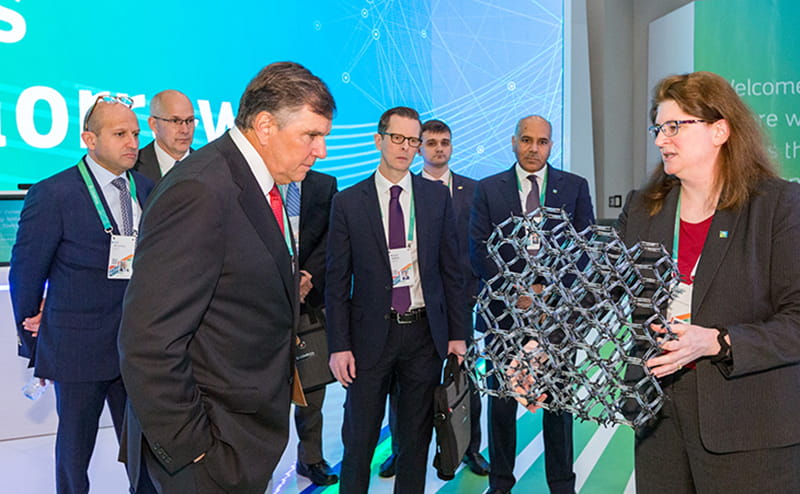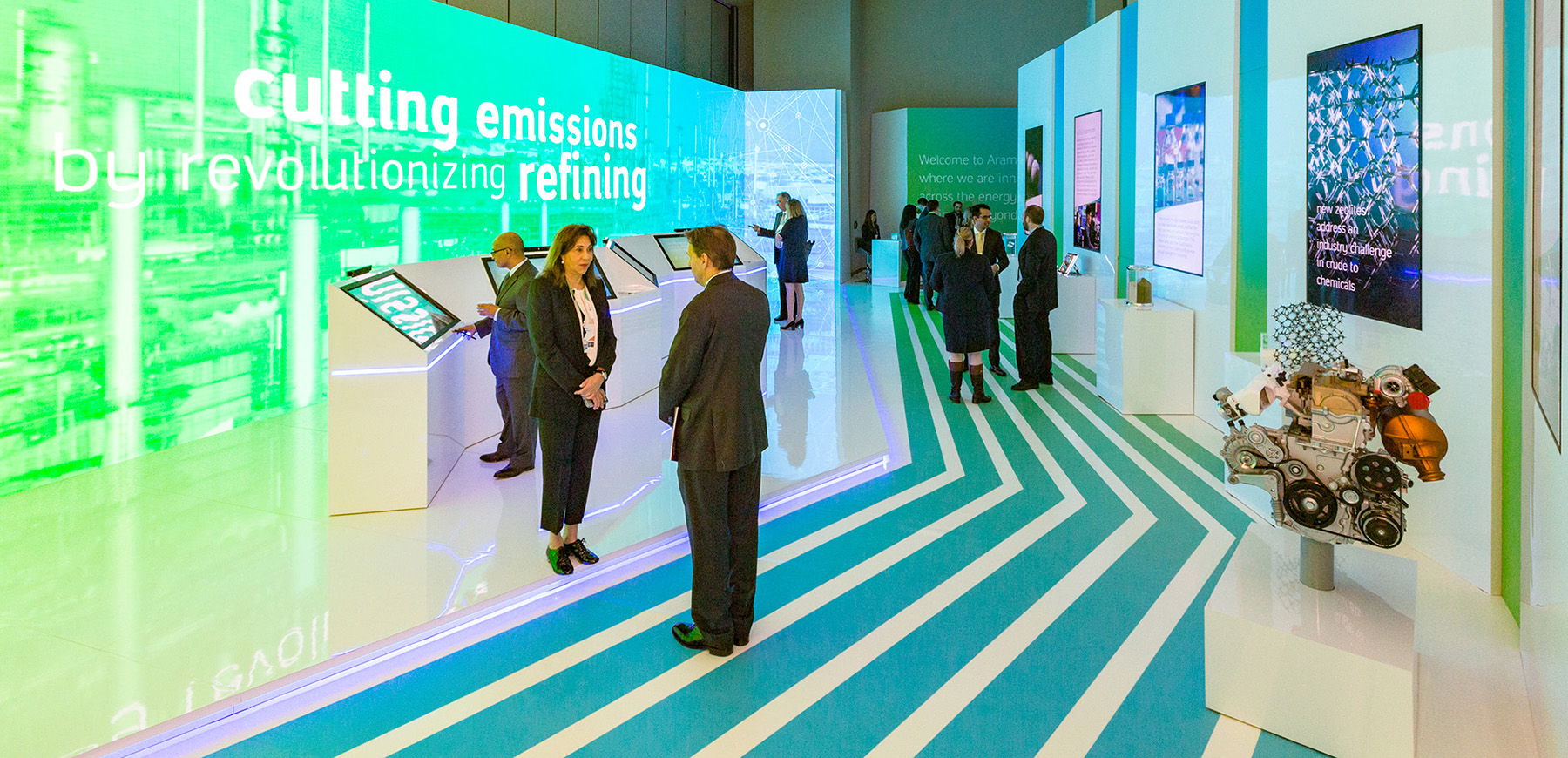Saudi Aramco's leading role in energy innovation was on full display at CERAWeek 2019 in Houston as the company's technology strategists and researchers discussed their latest solutions and spoke about the path forward for new technologies to drive sustainability in the industry.
Chief Technology Officer Ahmad Al-Khowaiter spoke on a panel called “Digital Transformation: Creating Value” and another titled “The Quiet ICE (Internal Combustion Engine) Revolution. New Tech Driving New Directions.”

Saudi Aramco CTO Ahmad
Al Khowaiter (center) participates in panel: The Quiet ICE (Internal
Combustion Engine) Revolution: New tech driving new directions during
CERAWeek 2019.
“Freeing up data to flow across silos and fully leverage it will allow the fourth industrial revolution to flourish,”
Saudi Aramco CTO Ahmad
Al Khowaiter
He told the audience that software advancements using artificial intelligence, Big Data, and predictive analytics have shown great promise in certain cases. To scale these applications across enterprises, companies must further develop the digital skills of workers and change work flows so that front-line personnel are constantly encouraged to test new tools in their jobs, he said.
Al-Khowaiter also spoke about the need for governments to ensure a sound policy environment that adequately addresses climate challenges. Looking at carbon emissions through a more holistic “wells-to-wheels” lens can help create better policy outcomes, especially when it comes to evaluating different transport technologies.
“Freeing up data to flow across silos and fully leverage it will allow the fourth industrial revolution to flourish,” he said.
Al-Khowaiter also spoke about the need for governments to ensure a sound policy environment that adequately addresses climate challenges. Looking at carbon emissions through a more holistic “wells-to-wheels” lens can help create better policy outcomes, especially when it comes to evaluating different transport technologies.
Given the consensus among all major forecasts that ICEs will make up the overwhelming majority of the world's light-duty vehicle fleet for decades to come, the development of cleaner-burning engines would reduce emissions faster and more economically than trying to switch fleets around the world to electric vehicles, he said.
Saudi Aramco's research centers are developing new engines that boost fuel economy 30 percent or more and reduce particulate emissions to nearly zero.
“We see ourselves as being a catalyst that brings together energy companies and automakers so that important advancements can be made by conducting innovative research on new fuels and new engines simultaneously,” he said.

Aramco Detroit Research Center Leader David Cleary and US Dept. of Energy Secretary Rick Perry discuss Aramco's ultra-clean engines.
“Compared to batteries, hydrogen appears much easier to scale for use in
heavy duty trucks or trains. And the good thing about hydrogen is that
it is plentiful and can easily be isolated from hydrocarbons,”
Detroit Research Center Leader David Cleary
Clean Tech and Hydrogen
Bashir Dabbousi, Director of Technology Strategy & Planning, spoke at one called “The New Energy Transition: Opportunities in Clean Tech?” He discussed how the company is focusing much of its resources on developing low greenhouse gas emissions technologies, converting crude directly to chemicals as well as leading investments in cleaner technologies through Saudi Aramco Energy Ventures and the Oil and Gas Climate Initiative (OGCI), which held its second venture day on industrial and transport efficiency during CERAWeek. He also explained Aramco's long history of lowering the carbon intensity of its crude production by achieving near zero flaring intensity, using best in-class reservoir management practices and technologies and driving for massive energy efficiency improvements across all of its operations.
Dabbousi also spoke at an engaging roundtable discussion titled “What does the hydrogen transportation economy look like?” Participants debated the prospect of hydrogen fuel-cell electric vehicles supplanting battery electric vehicles. Dabbousi noted that hydrogen-powered vehicles can offer drivers longer ranges and shorter refueling times than battery-powered ones.
Saudi Aramco, he said, is partnering to build the Kingdom's first hydrogen fueling station for cars this year and that hydrogen may have better prospects than batteries for a range of low carbon transport applications.
“Compared to batteries, hydrogen appears much easier to scale for use in heavy duty trucks or trains. And the good thing about hydrogen is that it is plentiful and can easily be isolated from hydrocarbons,” he told the audience.

Katie Hull (right) of Aramco Research Center – Houston speaks with officials from the India ONGC about new energy technology at the CERAWeek Innovation Agora Aramco House in Houston.
Delegations Visit Booth
The Saudi Aramco booth provided visitors with a chance to hear our researchers speak about their work and to take in-depth digital tours of more than two dozen new technologies the company has developed for the upstream, downstream and automotive industries, among others.
U.S. dignitaries who toured the booth included Secretary of Energy Rick Perry and Environmental Protection Agency Administrator Andrew Wheeler.
Delegations from China, India and the African nations of Nigeria, Kenya, Uganda, South Sudan and Equatorial Guinea also visited the booth, as did Emerson CEO David Farr.

U.S. EPA Administrator Andrew Wheeler (right) speaks with researchers about cleaner energy technologies being developed by Aramco.
U.S. R&D Centers
Scientists and engineers based at our research centers in Detroit, Boston and Houston were at the booth, along with Mohammed Khayyal, who spoke about Industrial Revolution 4.0 technologies the company has deployed at the Ulhmaniyah gas plant, work that has won kudos from the World Economic Forum.
Michele Ostraat, Downstream Technology Leader of the Boston Research Center, spoke about identifying corrosion where it first forms and the creation of new zeolite catalysts to turn crude into chemicals. Huseyin Seren, Laboratory Scientist, Katherine Hull, Sr. Laboratory Scientist, and Amy Cairns, Chemist, of the Houston research center presented upstream technologies, including wireless sensors for reservoir data collection and techniques to transform Saudi sand for hydraulic fracturing.
David Cleary, Detroit Research Center Leader, and Burke Davis, Engineer, discussed Gasoline Compression Ignition and other technologies to boost fuel economy and slash tailpipe emissions from vehicles.
“High-level dignitaries were excited to have had the chance to interact face-to-face with Aramco researchers. This made our booth experience unique,” said Ashraf Tahini, Director of Research & Development in the United States.

Boston Research Center Downstream Technology Leader Michele Ostraat (right) speaks with Emerson CEO David Farr (left) about new zeolite catalysts.
For media inquiries involving U.S.-based operations, submit your inquiry here. For inquiries related to our parent company, Saudi Aramco, please email directly to: international.media@aramco.com.




